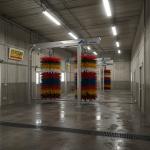Selecting the right truck wash equipment is a major decision that directly impacts your operational efficiency, maintenance costs, and brand image. With a wide array of systems available, from manual pressure washers to fully automated drive-through bays, making the best choice can feel overwhelming. A strategic approach, however, ensures you invest in a solution that fits your specific needs and delivers a strong return.
This article will guide you through the critical factors to consider when choosing truck wash equipment. We will explore how to assess your fleet’s requirements, align your budget with long-term value, and account for environmental regulations. By following these steps, you can confidently select a system that keeps your trucks clean and your business running smoothly.
1. Assess Your Fleet Size and Wash Frequency
The first step in choosing equipment is to analyze the scale of your operation. The number of vehicles you manage and how often they need to be washed will be the primary driver of your decision.
- Small Fleets (1-10 trucks): If you manage a small fleet and wash vehicles weekly, a high-quality manual setup is often the most cost-effective solution. A commercial-grade hot water pressure washer, combined with foam cannons and long-handled brushes, provides excellent cleaning power without a massive upfront investment. This approach is labor-intensive but offers flexibility and low initial costs.
- Medium Fleets (11-50 trucks): For fleets of this size, balancing automation and cost becomes key. A gantry or “rollover” system is an excellent option. The truck remains stationary while an automated unit moves over it, washing and rinsing the vehicle. This significantly reduces manual labor and ensures a consistent, high-quality wash every time. It requires less space than a drive-through system, making it suitable for many existing facilities.
- Large Fleets (50+ trucks): When dealing with a large volume of vehicles requiring daily or frequent washing, speed and throughput are paramount. A drive-through wash system is the most efficient choice. Trucks are driven slowly through a series of arches that perform different functions—pre-soaking, brushing, high-pressure rinsing, and even waxing. These systems can wash a full semi-truck in a matter of minutes, maximizing vehicle uptime.
2. Evaluate Your Specific Cleaning Needs
Not all fleets face the same type of dirt and grime. The nature of your routes and cargo will dictate the level of cleaning power you require.
- Highway and Long-Haul Fleets: Trucks that primarily travel on paved highways mostly accumulate road film, bug residue, and general dust. A system with good quality detergents, effective brushes, and high-pressure rinsing is usually sufficient.
- Vocational Fleets (Construction, Agriculture, Mining): These vehicles operate in harsh environments and are constantly exposed to thick mud, clay, and abrasive debris. For these applications, your equipment must include powerful undercarriage cleaners and hot water pressure washing capabilities to break down heavy, caked-on grime.
- Fleets in Cold Climates: If your trucks operate in regions with snow and ice, they are regularly exposed to corrosive road salts and de-icing chemicals. This makes an undercarriage wash system non-negotiable. Hot water is also highly effective at dissolving salt, helping to prevent rust and extend the life of your vehicle’s frame and components.
- Tankers and Food-Grade Haulers: Fleets hauling sensitive materials may need specialized cleaning solutions, including interior washout systems or sanitizing functions to meet industry regulations.
3. Analyze Your Budget and Calculate ROI
The initial purchase price is only one part of the total cost of ownership. A smart investment considers both the upfront capital and the long-term operational expenses.
- Initial Investment: Manual systems have the lowest entry cost, while fully automated drive-through systems represent the largest capital expenditure.
- Operating Costs: This is where automation often pays for itself. Factor in the ongoing costs of:
- Labor: Calculate how many hours your team spends washing trucks manually versus overseeing an automated system. A gantry or drive-through system can drastically reduce labor costs per wash.
- Water and Sewer: A typical manual truck wash can use over 100 gallons of fresh water per vehicle. An automated system is often more efficient, and when paired with a water reclaim system, it can cut water consumption by up to 80%.
- Detergents and Chemicals: Automated chemical injectors mix precise amounts of soap, reducing waste compared to manual application. This alone can lead to significant savings on consumables.
When evaluating a more expensive automated system, calculate the return on investment (ROI). For example, if an automated system saves you $2,000 per month in labor and $500 in water bills, it provides $30,000 in annual savings. This can make a higher initial investment pay for itself in just a few years.
4. Consider Space and Site Requirements
Your physical location will impose constraints on your equipment choices. Before you commit to a system, perform a thorough site assessment.
- Available Footprint: Do you have enough space for a wash bay? Drive-through systems require a long, straight path for entry and exit. Gantry systems need a long bay but are generally more compact. Measure your available length, width, and, critically, your ceiling height.
- Utilities: Ensure you have adequate access to water, electricity (including three-phase power for larger systems), and natural gas if you plan to use hot water heaters.
- Drainage and Environmental Compliance: Your wash bay must have proper drainage to handle the water volume. More importantly, you must comply with local and federal environmental regulations regarding wastewater discharge. Many municipalities prohibit the release of oily, chemical-laden water into the storm drain. This leads to the next critical factor.
5. Factor in Environmental and Regulatory Considerations
Environmental stewardship is no longer optional—it’s a business necessity. Ignoring regulations can lead to heavy fines and operational shutdowns.
A water reclaim system is a key piece of equipment for achieving compliance and sustainability. These systems capture used wash water, filter out solids, oils, and contaminants, and then recycle it for future washes. The benefits are twofold:
- Compliance: It helps you meet stringent environmental discharge laws, protecting you from legal trouble.
- Cost Savings: By dramatically reducing your water and sewer usage, a reclaim system lowers your utility bills and provides a hedge against future rate increases.
While it adds to the initial investment, a water reclaim system is often essential for obtaining permits and is a financially prudent choice for any high-volume wash operation.
Making a Confident Decision
Choosing the best truck wash equipment is a strategic process of matching your fleet’s unique profile with the right technology. Start by quantifying your wash volume and identifying your specific cleaning challenges. Then, create a comprehensive budget that looks beyond the sticker price to include long-term operational savings. Finally, ensure your plan aligns with your site’s physical limitations and all environmental regulations.
By carefully considering these factors, you can invest in a truck wash system that not only keeps your fleet looking professional but also enhances maintenance, protects your assets, and strengthens your bottom line.




